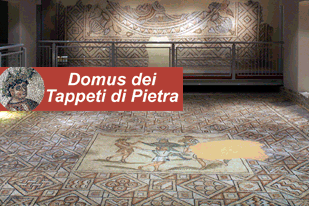The Dominican cloister. Dante's Era.





The Dominican cloister at San Giovanni Evangelista. Hotels near the Dominican cloister .
Photo : 1)the elegant 14th century portal at the entrance of San Giovanni Evangelista
2)the Dominican cloister at San Giovanni Evangelista, 3)fragment of the frescos on the cross vault of the chapel, 4)a figure of the floor mosaic, 5)detail of the portal
The church of San Giovanni Evangelista was built in the 5th century. It subsequently became the seat of a Benedictine monastery, the presence of which has been documented since the 10th century.
In the mid 15th century it passed into the hands of the Canons regular of San Salvatore di Bologna, becoming one of the four great abbeys of Ravenna, together with San Vitale, Sant'Apollinare in Classe and Santa Maria in Porto.
Following the Napoleonic expropriations it became the town hospital, up until the 2nd world war destruction of 1944.
On the re-building of the church, the elegant 14th century portal at the entrance to the parvis was also restored. The lunette, under the tympan, depicting an episode from Medieval literary tradition that explains the origins of the building itself.
At the centre is a representation of Galla Placidia, prostrated in front of John the Evangelist, who acted to save her during a storm at sea, following her pleas for help, together with those of a Saint Barbaziano, her confessor, standing behind her.
The hand of Placidia is extended to take a sandal of John, conserved as a relic. In her gratitude for having her life saved, she wanted to name the church after the saint that thanks to his intervention had legitimated that journey bringing her to Italy from Constantinople, where Placidia had obtained the regency of the western empire.
The narrated event was collected by the archbishop Rinaldo da Concorezzo, a respected cultural personality at the time of Dante. The manuscript is conserved in the Classense Library and contains precious miniatures that illustrate the sea journey of Galla Placidia.
Inside the church, the 14th century chapel, on the left side, featured frescoes walls and cross vaulting, depicting images of the evangelists and Doctors of the Church, as well as a Crucifixion and a Madonna with Child and saints. Only fragments now remain, the work of anonymous painters in late Gothic style.
There are also many remains of the floor mosaics dated 1213, which vividly depict the battles of the 4th crusade, religious and cosmological concepts, references to legends, bestiaries, and the themes of courtly love, all being expressions of the highly varied and complex Medieval imagination. An ancient story, narrate show one of the church bells was founded in 1208 by a certain Robert, from Saxony.
He had with him his young daughter, who was sad and forlorn after a delusion in love. While helping her father, some of her tears fell into the bronze. "This is why - wrote Marino Moretti in his novel "I due fanciulli" – that the bell of San Giovanni Evangelista makes such a strange sound ... As if it is still sobbing!"
Prof. Gianni Morelli
See: Medieval Mosaics
see: floor mosaics
The pleasure of fine accommodation in the centre of Ravenna: we recommend the Fabbri hotels for a pleasant stay as follows:
The Centrale Byron hotel, 3-star, in the centre of Ravenna, close to the Dominican cloister at San Giovanni Evangelista ;
The Bisanzio Hotel, 4-star hotel in the centre of Ravenna, close to the Dominican cloister at San Giovanni Evangelista ;





